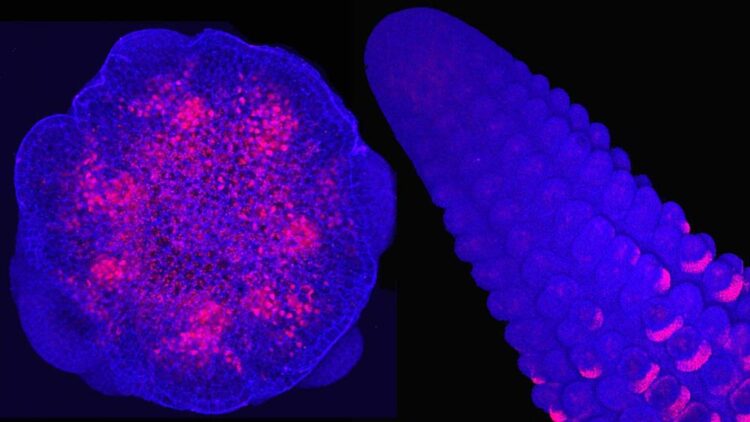Building a corn cob–cell by cell, gene by gene

Thousands of genes are needed in order for baby corn to develop properly. CSHL Professor David Jackson mapped gene expression (genes turning on and off) in a tiny developing ear of corn. On the right, a 5 mm-long ear of corn is developing kernel buds (blue). The gene ZmYAB14 (red) is turned on in the older buds toward the bottom of the picture. The left image shows a slice of a 5 mm-long ear of corn. The ZmSHR1-like gene (red) lights up cells that transport water and nutrients.
Credit: Xiaosa Xu/Jackson lab, CSHL, 2020
Corn hasn’t always been the sweet, juicy delight that we know today. And, without adapting to a rapidly changing climate, it is at risk of losing its place as a food staple. Putting together a plant is a genetic puzzle, with hundreds of genes working together as it grows. Cold Spring Harbor Laboratory (CSHL) Professor David Jackson worked with Associate Professor Jesse Gillis to study genes involved in corn development.
Their teams analyzed thousands of individual cells that make up the developing corn ear. They created the first anatomical map that shows where and when important genes turn on and off during key steps in development. This map is an important tool for growing better crops.
Humans have been breeding corn to make it more useful for thousands of years. Jackson says:
“Ten thousand years ago, corn did not exist, right? There was a wild plant called teosinte. Teosinte itself only makes about 10 seeds. It makes these really tiny ears that don’t give much nutrition. In fact, the seeds they make are so tough that they would break your teeth if you try to eat them anyway.”
The secret to more and bigger kernels is found by looking at baby ears of corn 1-10 mm long. The scientists used a technique that allowed them to track every cell. They gave each cell a genetic ID tag, called a barcode. Xiaosa Xu, the lead author of the study, compares it to building a building. Xu says:
“We are able to use this single-cell RNA-seq technology to identify which block is what kind of identity: if this block is from our kitchen room or that block is from our bedroom.”
The scientists took corn plants at early stages of development, broke them into individual cells, barcoded them, and then saw what genes were turned on in each one. Jackson notes, “in the past we haven’t been able to separate the cells and figure out the genetic information that’s specific to each cell. So that’s really, what’s new and exciting.” They could then reconstruct an anatomical map to pinpoint where genes important for corn development were used.
Crops are still evolving. Jackson looks forward to developing different kinds of corn plants to fill new ecological niches. He also hopes this new technique will help other plant geneticists in their efforts to sustainably improve crop yields.
All latest news from the category: Life Sciences and Chemistry
Articles and reports from the Life Sciences and chemistry area deal with applied and basic research into modern biology, chemistry and human medicine.
Valuable information can be found on a range of life sciences fields including bacteriology, biochemistry, bionics, bioinformatics, biophysics, biotechnology, genetics, geobotany, human biology, marine biology, microbiology, molecular biology, cellular biology, zoology, bioinorganic chemistry, microchemistry and environmental chemistry.
Newest articles

Machine learning algorithm reveals long-theorized glass phase in crystal
Scientists have found evidence of an elusive, glassy phase of matter that emerges when a crystal’s perfect internal pattern is disrupted. X-ray technology and machine learning converge to shed light…

Mapping plant functional diversity from space
HKU ecologists revolutionize ecosystem monitoring with novel field-satellite integration. An international team of researchers, led by Professor Jin WU from the School of Biological Sciences at The University of Hong…

Inverters with constant full load capability
…enable an increase in the performance of electric drives. Overheating components significantly limit the performance of drivetrains in electric vehicles. Inverters in particular are subject to a high thermal load,…





















